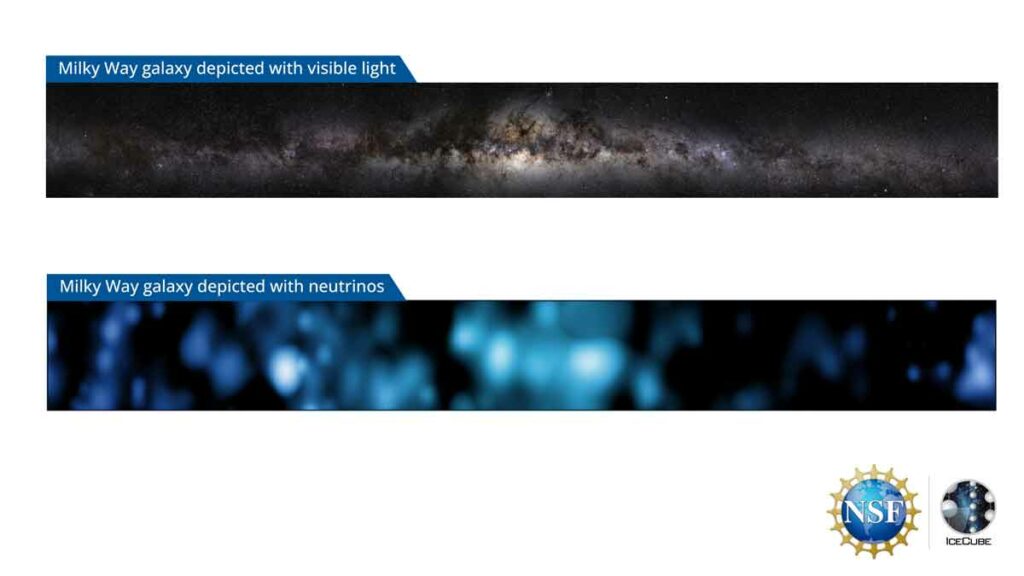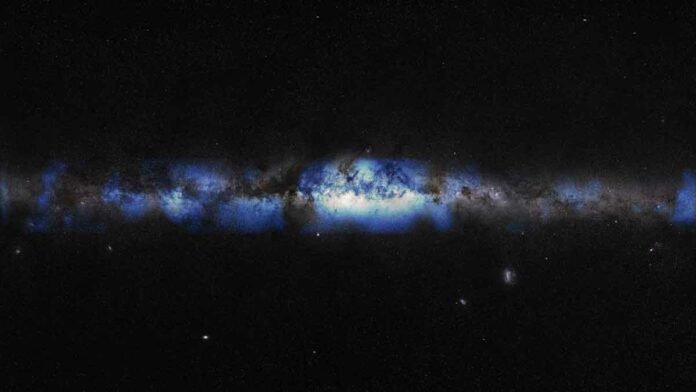In a groundbreaking discovery, the IceCube Neutrino Observatory has captured an extraordinary image of our Milky Way galaxy using elusive particles called neutrinos.
The observatory, operated by an international team of over 350 scientists known as the IceCube Collaboration, has published their findings in the esteemed journal Science, presenting compelling evidence of high-energy neutrino emissions from our galaxy.
Neutrinos, often described as ghostlike messengers from the cosmos, possess energies millions to billions of times greater than those generated by star-fueled fusion reactions.
The IceCube Neutrino Observatory, located at the Amundsen-Scott South Pole Station, is an unprecedented gigaton detector spanning a cubic kilometer of Antarctic ice, equipped with over 5,000 light sensors.
Its primary mission is to seek out signs of high-energy neutrinos originating from both within our galaxy and beyond, extending to the farthest reaches of the universe.
Professor Francis Halzen, the principal investigator of IceCube and a physicist at the University of Wisconsin–Madison, explains, "What's truly fascinating is that, unlike light at any wavelength, the universe shines brighter in neutrinos than the nearby sources within our own galaxy."

This revelation opens up a new window of exploration, made possible by the remarkable capabilities of the highly sensitive IceCube detector, coupled with advanced data analysis tools.
Director Denise Caldwell of the Physics Division at the National Science Foundation expresses her excitement, stating, "Scientific breakthroughs of this magnitude are often enabled by technological advancements.
The remarkable capabilities provided by the IceCube detector, along with cutting-edge data analysis techniques, have granted us an unprecedented view of our galaxy—a view that was previously only hinted at.
As these capabilities continue to improve, we anticipate unveiling even finer details of our galaxy, potentially uncovering hidden features never before seen by humanity."
The IceCube Collaboration’s quest to detect high-energy neutrinos emanating from the Milky Way concentrated on the southern sky, where the bulk of such emissions from the galactic plane were expected, particularly near the center of our galaxy.
However, the presence of background muons and neutrinos, generated by cosmic-ray interactions with Earth’s atmosphere, presented significant challenges.

To overcome these obstacles, IceCube collaborators at Drexel University devised advanced analysis techniques that focused on selecting “cascade” events—neutrino interactions in the ice that result in spherical showers of light.
By concentrating on cascade events that originate within the instrumented volume, contamination from atmospheric muons and neutrinos was substantially reduced.
This approach allowed for greater purity in the detection of astrophysical neutrinos originating from the southern sky.
Nevertheless, the ultimate breakthrough came when machine learning methods, developed by IceCube collaborators at TU Dortmund University, were implemented.
These methods significantly enhanced the identification of neutrino-induced cascades, as well as the reconstruction of their direction and energy.
The observation of neutrinos from the Milky Way represents a remarkable milestone, highlighting the critical role that machine learning plays in data analysis and event reconstruction within the IceCube project.
Mirco Hünnefeld, a physics Ph.D. student at TU Dortmund, IceCube member, and co-lead analyzer, explains, "These improved methods allowed us to retain over ten times more neutrino events, resulting in an analysis that is three times more sensitive than previous searches."
The team examined a dataset comprising 60,000 neutrinos collected over a decade of IceCube observations—thirty times the number of events used in prior analyses of the galactic plane based on cascade events.
These neutrinos were then compared to prediction maps derived from extrapolated gamma-ray observations made by the Fermi Large Area Telescope, as well as alternative maps developed by a group of theorists known as KRA-gamma.
Professor Wolfgang Rhode of TU Dortmund University, IceCube member, and Hünnefeld's advisor, lauds the achievement, saying, "This long-awaited discovery of cosmic ray interactions within our galaxy is an outstanding example of what can be accomplished when modern machine learning methods are consistently applied to knowledge discovery."
The power of machine learning opens up exciting possibilities, bringing other observations within closer reach.
IceCube spokesperson Professor Ignacio Taboada, from the Georgia Institute of Technology, emphasizes, "The substantial evidence pointing to the Milky Way as a source of high-energy neutrinos has withstood rigorous testing by the IceCube Collaboration. The next phase of our mission is to identify specific sources within our galaxy."
These intriguing questions and more will be explored in forthcoming analyses conducted by the IceCube team.
Professor Naoko Kurahashi Neilson of Drexel University, IceCube member, and advisor to Steve Sclafani—a physics Ph.D. student at Drexel University and IceCube collaborator—reflects on this momentous achievement, stating, "Observing our own galaxy through the lens of particles rather than light marks a monumental leap forward in scientific understanding. As neutrino astronomy continues to evolve, we will gain an entirely new perspective with which to observe the vast wonders of our universe."
Excitement abounds within the scientific community as the IceCube Neutrino Observatory’s groundbreaking image of the Milky Way paves the way for further exploration, unlocking the secrets of our cosmic neighborhood through the enigmatic world of neutrinos.
FAQs
The IceCube Neutrino Observatory is a scientific facility operated by an international collaboration of scientists. It is located at the Amundsen-Scott South Pole Station and is designed to detect high-energy neutrinos originating from our galaxy and beyond. The observatory consists of a cubic kilometer of Antarctic ice, instrumented with thousands of light sensors.
Neutrinos are subatomic particles that are incredibly lightweight and have no electric charge. They interact very weakly with matter, making them difficult to detect. Neutrinos are often referred to as “ghostlike” particles because they can pass through vast amounts of material without being affected.
The detection of high-energy neutrinos from the Milky Way is significant because it provides valuable insights into the processes occurring within our galaxy. Neutrinos can reveal information about cosmic rays, interactions with galactic gas and dust, and the presence of astrophysical sources. It allows scientists to study the universe using particles instead of relying solely on traditional observations of light.
The IceCube Neutrino Observatory detects neutrinos by observing the faint flashes of light produced when neutrinos interact with the Antarctic ice. The facility is equipped with thousands of light sensors, which can capture these signals. By analyzing the patterns of light, scientists can infer the properties of the detected neutrinos, such as their energy and direction of arrival.
Machine learning techniques have been employed in the IceCube project to enhance the identification and analysis of neutrino-induced cascades. By utilizing advanced algorithms, machine learning helps improve the accuracy and efficiency of event reconstruction, ultimately leading to a better understanding of the detected neutrinos. It allows researchers to extract more valuable information from the vast amount of data collected by the observatory.
The detection of high-energy neutrinos from the Milky Way opens up new avenues of exploration in the field of neutrino astronomy. It offers a unique perspective for studying cosmic phenomena and identifying specific sources within our galaxy. This discovery also highlights the potential of machine learning in advancing data analysis techniques, which can lead to further breakthroughs in our understanding of the universe.
More information: IceCube Collaboration, Observation of high-energy neutrinos from the Galactic plane, Science (2023). DOI: 10.1126/science.adc9818. www.science.org/doi/10.1126/science.adc9818

